
Admiral Flota Sovetskogo Soyuza Kuznetsov is an aircraft carrier that has served as the flagship of the Russian navy. It was built by the Black Sea Shipyard, the sole manufacturer of Soviet aircraft carriers, in Nikolayev within the Ukrainian Soviet Socialist Republic and launched in 1985, becoming fully operational in the Russian Navy in 1995. The initial name of the ship was Riga; it was launched as Leonid Brezhnev, embarked on sea trials as Tbilisi, and was finally named after Admiral of the Fleet of the Soviet Union Nikolay Gerasimovich Kuznetsov.
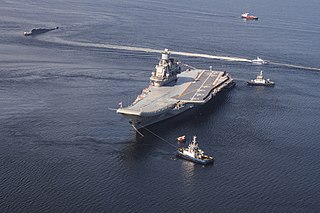
The Kuznetsov-class aircraft carrying cruiser, Soviet designation Project 1143.5, is a class of STOBAR aircraft carriers operated by the Russian and Chinese navies. Originally designed for the Soviet Navy, the Kuznetsov-class ships use a ski-jump for launching high-performance jet aircraft and arrestor gears for landing. The design represented a major advance in Soviet fleet aviation over the Kiev-class carriers, which do not have full-length flight deck and could only launch VSTOL aircraft. The Soviet Union's classification for the class was as a heavy aircraft-carrying cruiser, which permits the ships to transit the Turkish Straits without violating the Montreux Convention. However, the Chinese variants are classified as aircraft carriers.

A dry dock is a narrow basin or vessel that can be flooded to allow a load to be floated in, then drained to allow that load to come to rest on a dry platform. Dry docks are used for the construction, maintenance, and repair of ships, boats, and other watercraft.

Sevmorput is a Russian nuclear-powered cargo ship. The 1988-built vessel is one of only four nuclear-powered merchant ships ever built and, after returning to service in 2016 following an extensive refit, the only such vessel to remain in service as of 2023.
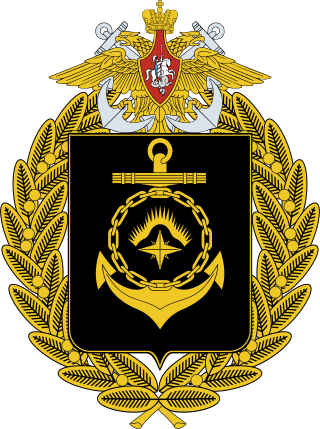
The Northern Fleet is the fleet of the Russian Navy in the Arctic.

Kirov is the lead ship of the Kirov class of nuclear-powered guided missile cruisers. Originally built for the Soviet Navy and passed onto the succeeding Russian Navy, she and her three sister ships are the largest and heaviest surface combatant warships built by them. The Soviet classification of the ship-type is "heavy nuclear-powered guided missile cruiser", nonetheless Kirov's size and weapons complement have earned her the unofficial designation of a battlecruiser throughout much of the world, as her size and displacement is similar to a typical World War I battleship. The appearance of the Kirov class was a significant factor in the U.S. Navy recommissioning the Iowa class. She was named after a Project 26 cruiser.

Baku was one of six Leningrad-class destroyer leaders built for the Soviet Navy during the 1930s, one of the three Project 38 variants. Completed in late 1939, the ship was assigned to the Pacific Fleet. About a year after the German invasion of Russia in June 1941, she was ordered to join the Northern Fleet, sailing through the Arctic Ocean. Together with several other destroyers, Baku left the Soviet Far East in July 1942 and arrived off Murmansk three months later where she began escorting convoys, mostly in the White and Barents Seas. The ship was badly damaged in a storm that sank another Soviet destroyer in November and was under repair for several months. Baku spent most of the rest of the war on convoy escort duties, although she did bombard several German-occupied towns during the Petsamo–Kirkenes Offensive of October 1944. The ship and her crew were awarded the Order of the Red Banner in early 1945 for their performance during the war.

Admiral Nakhimov is the third battlecruiser of the Russian Navy's Kirov class. The ship was originally commissioned into service with the Soviet Navy in 1988, known back then as Kalinin (Калинин), a name the ship kept until 1992 when it was renamed for Pavel Nakhimov. From 1997 Admiral Nakhimov is undergoing a repair and a refit to receive new and improved weaponry and had been scheduled to re-enter service with the Russian Navy in around 2022. The date for the ship's return to service is uncertain. In 2021 it was reported that the ship's return to service would be delayed until "at least" 2023 while in February 2022 it was reported that Sevmash CEO Mikhail Budnichenko noted that the warship was planned for delivery in 2022. Later in the year it was again reported that the vessel's return to service might be delayed as late as 2024, with this being eventually confirmed by the head of United Shipbuilding Corporation Alexei Rakhmanov.

The Black Sea Shipyard was a shipbuilding facility in Mykolaiv, Ukraine, on the southern tip of the Mykolaiv peninsula. It was founded in 1895 by Belgian interests and began building warships in 1901. At the beginning of World War I in 1914, it was one of the largest industrial facilities in the Russian Empire. The shipyard was moribund in the first decades of the Soviet Union until the Soviets began building up their fleet in the 1930s and it began building surface warships as well as submarines. The yard was badly damaged during World War II and took several years to be rebuilt. Surface warship construction temporarily ended in the mid-1950s before being revived in the mid-1960s and submarines were last built in the yard in late 1950s. The Black Sea Shipyard built all of the aircraft carrying ships of the USSR and Russia and continued before it was liquidated by the economic court of Mykolaiv Oblast on June 25, 2021.
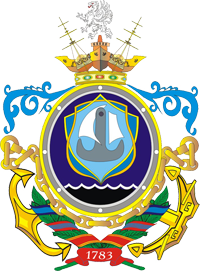
Sevastopol Shipyard is a shipyard located in Sevastopol, Crimea, founded as a dockyard for the Imperial Russian Navy in 1783.
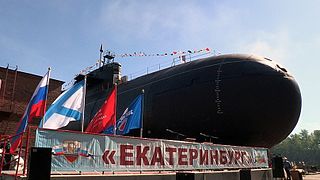
K-84 Ekaterinburg is a Project 667BDRM Delfin-class nuclear-powered ballistic missile submarine. The submarine was laid down on 17 February 1982 at the Russian Northern Machine-Building Enterprise (Sevmash). It was commissioned into the Soviet Navy on 30 December 1985. After the collapse of the Soviet Union, the submarine continued to serve in the Russian Navy. Initially known only by its hull number, in February 1999 it was renamed after the city of Yekaterinburg.

Razyaryonny was one of 29 Gnevny-class destroyers built for the Soviet Navy during the late 1930s. Originally named Peredovoy, she was renamed Razyaryonny before completion in late 1941, and was assigned to the Pacific Fleet.

An auxiliary floating drydock is a type of US Navy auxiliary floating dry dock. Floating dry docks are able to submerge underwater and to be placed under a ship in need of repair below the water line. Water is then pumped out of the floating dry dock, raising the ship out of the water. The ship becomes blocked on the deck of the floating dry dock for repair. Most floating dry docks have no engine and are towed by tugboats to their destinations. Floating dry docks come in different sizes to accommodate varying ship sizes, while large floating dry docks come in sections and can be combined to increase their size and lift power. Ballast pontoon tanks are flooded with water to submerge or pumped dry to raise the ship.
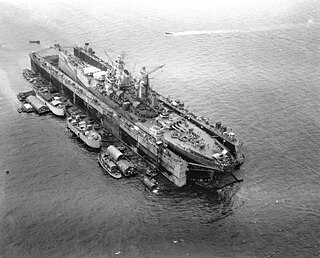
USS ABSD-2, later redesignated as AFDB-2, was a ten-section, non-self-propelled, large auxiliary floating drydock of the US Navy. Advance Base Sectional Dock-2 was constructed in sections during 1942 and 1943 by the Mare Island Naval Shipyard in Vallejo, California for World War II. Her official commissioning ceremony took place on 14 August 1943 with CDR Joseph J. Rochefort in command. With all ten sections joined, she was 927 feet (283 m) long, 28 feet (8.5 m) tall, and with an inside clear width of 133 feet 7 inches (40.72 m). ABSD-2 had a traveling 15-ton capacity crane with an 85-foot (26 m) radius and two or more support barges. The two side walls were folded down under tow to reduce wind resistance and lower the center of gravity. ABSD-2 had 6 capstans for pulling, each rated at 24,000 lbf (110,000 N) at 30 ft/min (0.15 m/s), 4 of the capstans were reversible. There were also 12 ballast compartments in each section.

USS ABSD-4, later redesignated as AFDB-4, was a nine-section, non-self-propelled, large auxiliary floating drydock of the US Navy. Advance Base Sectional Dock-4 was constructed in sections during 1942 and 1943 by the Mare Island Naval Shipyard in Vallejo, California for World War II. With all ten sections joined, she was 927 feet long, 28 feet tall, and with an inside clear width of 133 feet 7 inches. ABSD-4 had a traveling 15-ton capacity crane with an 85-foot radius and two or more support barges. The two side walls were folded down under tow to reduce wind resistance and lower the center of gravity. ABSD-4 had 6 capstans for pulling, each rated at 24,000 lbf (110,000 N) at 30 ft/min (0.15 m/s), 4 of the capstans were reversible. There were also 4 ballast compartments in each section.

USS ABSD-5, later redesignated as AFDB-5, was a nine-section, non-self-propelled, large auxiliary floating drydock of the US Navy. Advance Base Sectional Dock-5 was constructed in sections during 1943 and 1944 by the Chicago Bridge & Iron Company in Morgan City, Louisiana for World War II. With all nine sections joined, she was 825 feet long, 28 feet tall, and with an inside clear width of 133 feet 7 inches. ABSD-5 had two traveling 15-ton capacity crane with an 85-foot radius and two or more support barges. The two side walls were folded down under tow to reduce wind resistance and lower the center of gravity. ABSD-5 had 6 capstans for pulling, each rated at 24,000 lbf (110,000 N) at 30 ft/min (0.15 m/s), 4 of the capstans were reversible. There were also 4 ballast compartments in each section.
Pollock-Stockton Shipbuilding Company was established in 1942 to build ships needed for World War II. As part of the Emergency Shipbuilding Program the US Navy provided some of the capital to start Pollock-Stockton Shipbuilding at Stockton, California. The shipyard was located at San Joaquin River and Stockton Channel, near Louis Park. After the war the shipyard closed down in February 1946.
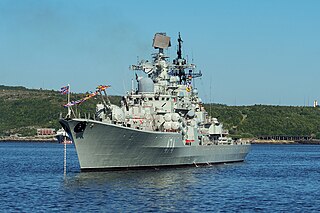
Admiral Ushakov is a Sovremenny-class destroyer of the Russian Navy. Previously she was named Besstrashny before being renamed in 2004.
The K-119 Voronezh is an Oscar-class submarine in the Russian Navy.


















